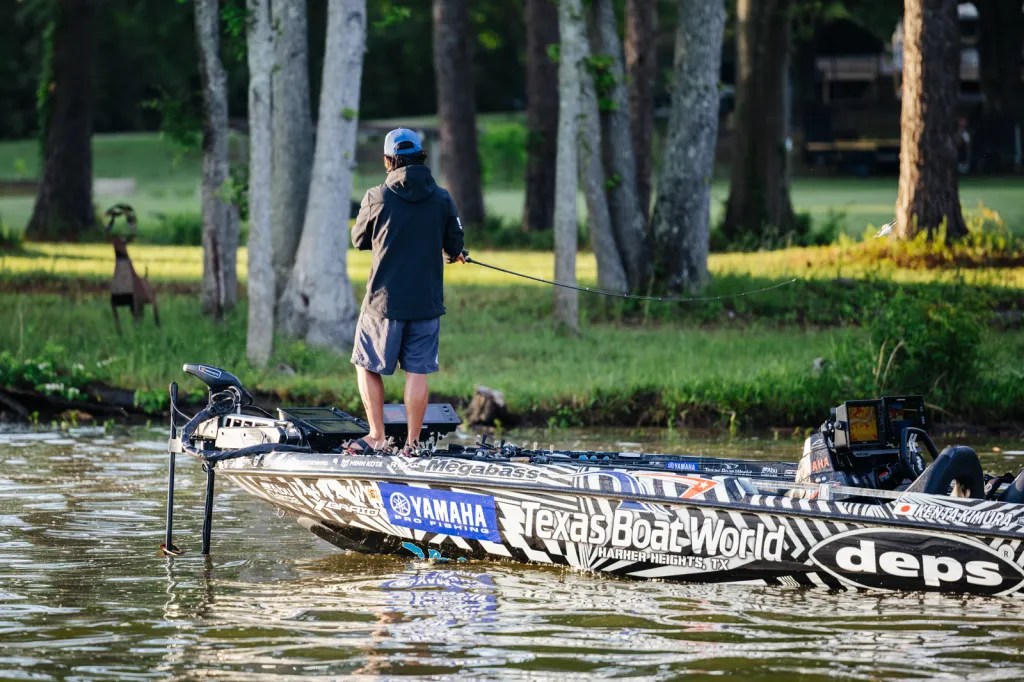
LINCOLN, Ala.—Capitalizing on an early morning shad spawn is a given, and after that flurry of opportunity fades away, the anglers are left with two main options at the St. Croix Bassmaster Open at Logan Martin presented by SEVIIN.
The first option for Tackle Warehouse Elite Qualifiers is to hunt down postspawners on the move. A full moon spawning cycle occurring just prior to the Open has those postspawn largemouth backtracking to deeper water. Keeping track of their daily movements can be time consuming. What’s more, postspawn largemouth lose valuable weight at the scales. But they also fill limits (and put weight on the scales).
Next is the option to target prespawners and bedding largemouth. Another wave of spawners is moving up as the tournament unfolds, putting that option into play.
On this Coosa River fishery, the water level is managed for flood control and power generation, and seeking bedding bass can be a risky proposition.
Summertime (and late spring) bass fishing success on Southern impoundments is typically contingent on power generation, and especially so on the Coosa River. Flip the switch and the bite turns on.
But Lake Logan Martin’s largemouth spawning season is unique, being that largemouth favor spawning when the lake reaches full pool. That is a gradual process that begins in April, and typically concludes May 1 when the lake reaches full pool.
That timeline also goes against the biological urge to spawn regardless of the water level. However, as the lake reaches full pool, more desirable spawning habitat is available.
Yesterday’s best bite came during the shad spawn, at least for Day 1 leader Josh Butler, whose limit weighing 19 pounds, 7 ounces, was anchored by a largemouth weighing 7-13. Butler caught that bass during a shad spawn, had a lightweight limit by 7:30 a.m. and then switched over to a spawning program.
“They (Alabama Power) turned the current on at 9 ‘o clock and, I won’t say I struggled, but it seems like it was tougher, said Butler, from Hayden, Ala.
There are opposing viewpoints on whether or not the largemouth spawn here during current flow. One side says they don’t, reason being newly born bass fry are swept from the beds and outside the protective zone of the males. The other side says it doesn’t matter; the bass just do it anyway.
Another Coosa River expert is Will Davis Jr. (10th; 14-9), the Bassmaster Elite Series pro who won last year in May on Lay Lake, next in the Coosa River series of lakes. Davis honed his tournament skills on both lakes, and offered this analogy of the unique spawning cycle at Logan Martin.
“The largemouth are conditioned to wait until the water begins to flood the best shoreline spawning habitat,” he said. “The current literally pulls them up with the rising water, setting it up for the perfect conditions.”
Davis added his experience proves the bigger females move up as the water level rises nearest full pool. In fact, on Day 1 he observed fry guarders (male largemouth) to reveal evidence of a spawn that likely occurred during a recent full moon.
With a decade of experience on Logan Martin, Alabamian Matt Adams (20th; 13-5) can further validate the available options in play this week.
“You have two options this week and those are bass moving up, or to target bass on the beds,” he said.
Notably, Adams described this scenario that is in play this week.
“A lot of anglers don’t realize they are catching spawners, because the rising water covered their beds.”
On Day 2 are two notable factors to watch. First, skies are forecasted to be partly cloudy to overcast as a low-pressure system moves in with good chances of rain on Friday evening and Saturday. That is compared to the clear and sunny conditions on Day 1. Second, the power generators remain idle until 1 p.m. Butler noted evidence of power generation at 9:30 a.m. on Day 1.





